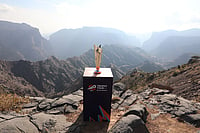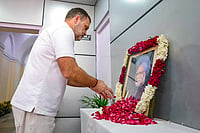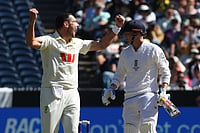It's cheap, it's supposed to be efficient and it has no frills. Air Deccan welcomes you to the new world of budget airlines. Describing his venture as an Udipi restaurant rather than Oberoi hotel, Captain Gopinath says Air Deccan will offer fares that are half its competitors' and, that too, "365-days-a-year". But there's no business class, or frequent flier programmes or Taj catering on these flights. In fact, you pay for the food served by a single air-hostess on board and there is free seating on the plane. So you might have to run, push and nudge a bit to get that window seat.
Launched with much fanfare two weeks ago, Air Deccan aims to capture the southern short-haul routes connecting small towns to big cities in Tamil Nadu, Karnataka and Andhra Pradesh. In another month, Captain Vivek Sane of Visaa Airways will start similar flights in the western region—connecting Mumbai to Pune, Surat, Kandla and Belgaum. While Visaa intends to serve free food on the plane, its fares will be as cheap; Mumbai-Pune will cost a mere Rs 850, compared to Rs 650 you pay for a first-class railway ticket.
And that's not all. Remember ModiLuft, which went down under some time ago? It now wants to take off as a low-cost airline under a new name, Royal Airways. Even Air-India was toying with a similar idea on international routes, but the proposal was rejected by its board last week. Says Jitendra Bhargava, spokesperson, Air-India: "Globally, everyone from Singapore Airlines to Swissair is looking at this option." He adds that United Airlines has set aside 40 aircraft to pursue a similar strategy.
But airlines like Air Deccan have modelled themselves on the successful low-budget international carriers like Ryan Air, EasyJet and South West Airlines. Says an excited Gopinath: "Today, Ryan Air, with a 10 per cent share of the European market, carries more passengers than British Airways and is hugely profitable." And he thinks the same can be replicated here. After all, he, like Sane, is trying to woo the rail passengers. "Anyone who can pay more than the first-class rail fare, but can't afford to fly Jet Airways is my target group," admits Gopinath.
No one can deny the idea's potential. So, Gopinath is ready to expand his fleet from the existing two 48-seater atrs to seven by mid-November and Sane will hit the runway with one 37-seater Dash 8, but increase that to five by next April. However, flying new sectors, as both Deccan and Visaa plan to do, is fraught with risks. For, no one can predict the volume of traffic that can be generated from those untested markets. Agrees a travel trade analyst: "Even Ryan Air only runs between existing routes. It is only in comparison with the existing full-fare airlines that your low-budget USP stands out."
Others feel that the main trunk routes in India are already over-serviced and there's little room for a new player to make a mark, even if he offers substantial discounts. While Gopinath says he has hedged his risks by plying both new and old routes, Sane is not worried about traffic. Pune, which is one of the places on his radar, is an already serviced destination. On his future routes, he says, the demand is there since "in 1988, Indian Airlines flew to all these sectors. I feel we may require 50-seater planes to cater to the demand".
One hopes he's right because that will be crucial for survival. While no-frills flights may have created a stir in aviation circles, the success will depend on ability to generate volumes. Globally, airlines operate on wafer-thin margins, usually 3-4 per cent. And a low-cost airline would be further squeezed. Hence, such operations have to generate traffic and, simultaneously, keep a tight leash on costs. Multi-tasking is one way to reduce manpower costs.So, the pilot welcomes the passengers aboard, there is little ground staff and bookings are largely done on the Net to reduce marketing costs, including travel agent commissions.
Sane feels cutting expenses is no big deal. After all, the Airports Authority of India offers discounts to aircraft below 21 tonnes. As a result, Visaa would save nearly 50 per cent on landing, navigation and baggage charges. "Besides, my manpower costs are low, just 50 employees per plane," he adds. In comparison, large carriers like Indian Airlines—although they operate jets—have more than 600 people per aircraft. Yet another way to remain profitable is to think of alternate revenue streams. Air Deccan has allowed Sun Microsystems to paint its logo on the exterior of the aircraft as well as distribute its brochures to passengers. This six-month contract will fetch the airline Rs 72 lakh.
Although travellers are excited about budget flying, the competition is yet to see them as a threat. While IA is adopting a wait-and-watch attitude, Air Sahara feels it's a completely different ball game that they would not like to get into. Says ceo Uttam Kumar Bose: "Nearly 50 per cent of our costs are fixed costs, like fuel and taxes, so we can't even look into a low-cost kind of operation. Further, they (Air Deccan) are catering to a different market." Most full-fare airlines are banking on the fact that the minnows will not be able to eat into their customer base since the latter are plying new routes.
Observes Subhash Goel of Stic Travels: "Budget airlines could start a new revolution in the travel industry, but that's only if they are allowed to stay in the market." Goel remembers a time some two decades ago when he used to represent an airline called Laker Airways in India. It had revolutionised the market by selling London-New York fares at $100. However, the airline, whose owner had been knighted, soon went bankrupt because the big daddies in the air matched them discount for discount until Laker Airways bled to death.
Don't forget that several Indian players, who banked on flying regional, short-haul routes, have failed miserably. ModiLuft, NEPC, Jagsons are just a few names in that long list. Worse, none of these new entrepreneurs are flush with cash. While Sane, a former Indian Airlines pilot, is being helped by a few NRIs, Gopinath hopes to use the profits earned by his parent company, Deccan Aviation, a successful helicopter and charter flight services firm. There are enough warnings here for the fledgling budget airlines!
Plane Vanilla
Short-hop flights for shoestring budgets could change the face of airline business

Plane Vanilla
Plane Vanilla
Published At:
MOST POPULAR
WATCH
MORE FROM THE AUTHOR
×





















